Input interpretation

1, 1-dibromoethane
Chemical names and formulas

formula | C_2H_4Br_2 name | 1, 1-dibromoethane alternate names | ethane, 1, 1-dibromo | ethane, 1, 1-dibromo- | ethylidene bromide | ethylidene dibromide mass fractions | Br (bromine) 85.1% | C (carbon) 12.8% | H (hydrogen) 2.15%
Lewis structure
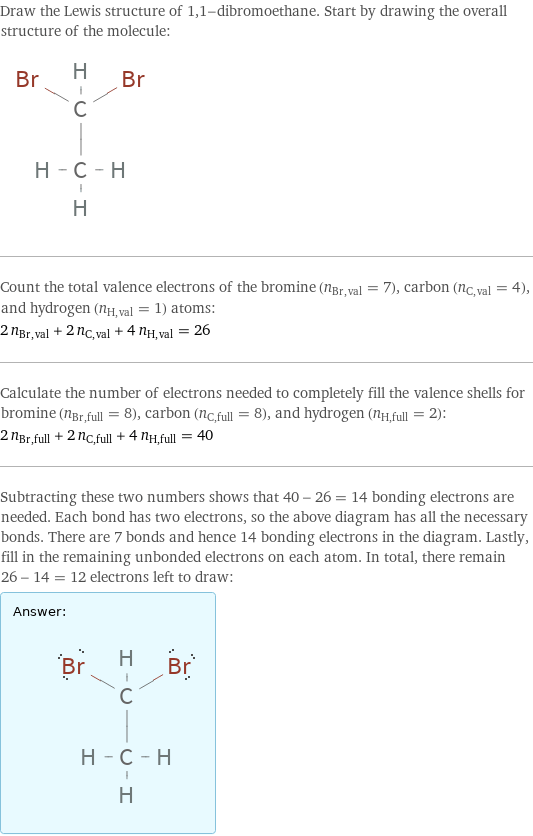
Draw the Lewis structure of 1, 1-dibromoethane. Start by drawing the overall structure of the molecule: Count the total valence electrons of the bromine (n_Br, val = 7), carbon (n_C, val = 4), and hydrogen (n_H, val = 1) atoms: 2 n_Br, val + 2 n_C, val + 4 n_H, val = 26 Calculate the number of electrons needed to completely fill the valence shells for bromine (n_Br, full = 8), carbon (n_C, full = 8), and hydrogen (n_H, full = 2): 2 n_Br, full + 2 n_C, full + 4 n_H, full = 40 Subtracting these two numbers shows that 40 - 26 = 14 bonding electrons are needed. Each bond has two electrons, so the above diagram has all the necessary bonds. There are 7 bonds and hence 14 bonding electrons in the diagram. Lastly, fill in the remaining unbonded electrons on each atom. In total, there remain 26 - 14 = 12 electrons left to draw: Answer: | |
3D structure

3D structure
Basic properties

molar mass | 187.86 g/mol phase | liquid (at STP) melting point | -0.5 °C boiling point | 108 °C density | 2.10294 g/cm^3 solubility in water | insoluble
Units

Liquid properties (at STP)
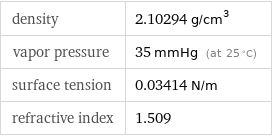
density | 2.10294 g/cm^3 vapor pressure | 35 mmHg (at 25 °C) surface tension | 0.03414 N/m refractive index | 1.509
Units

Thermodynamic properties
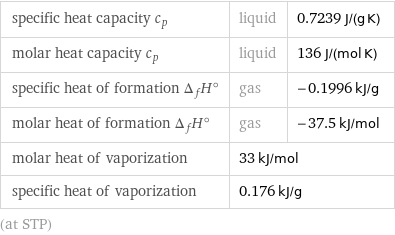
specific heat capacity c_p | liquid | 0.7239 J/(g K) molar heat capacity c_p | liquid | 136 J/(mol K) specific heat of formation Δ_fH° | gas | -0.1996 kJ/g molar heat of formation Δ_fH° | gas | -37.5 kJ/mol molar heat of vaporization | 33 kJ/mol | specific heat of vaporization | 0.176 kJ/g | (at STP)
Chemical identifiers
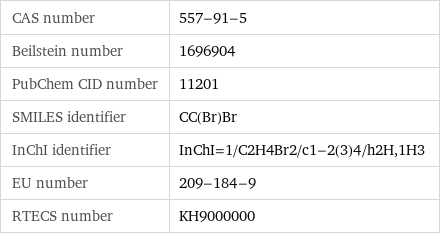
CAS number | 557-91-5 Beilstein number | 1696904 PubChem CID number | 11201 SMILES identifier | CC(Br)Br InChI identifier | InChI=1/C2H4Br2/c1-2(3)4/h2H, 1H3 EU number | 209-184-9 RTECS number | KH9000000
NFPA label

NFPA label
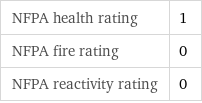
NFPA health rating | 1 NFPA fire rating | 0 NFPA reactivity rating | 0
Safety properties

flash point | -11 °C lower explosive limit | 3.9% (concentration in air) upper explosive limit | 20.5% (concentration in air)
Toxicity properties

RTECS classes | mutagen